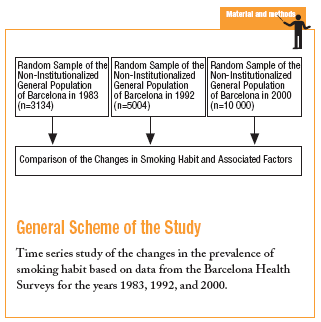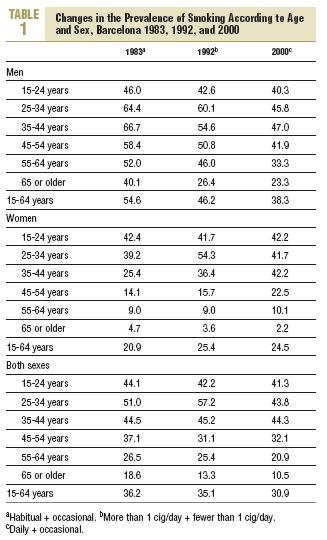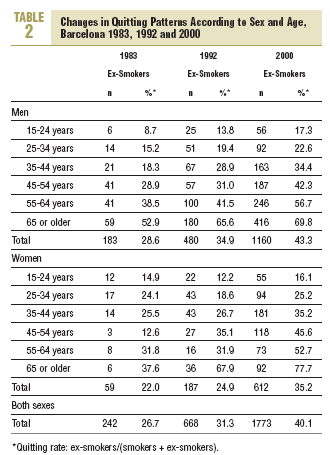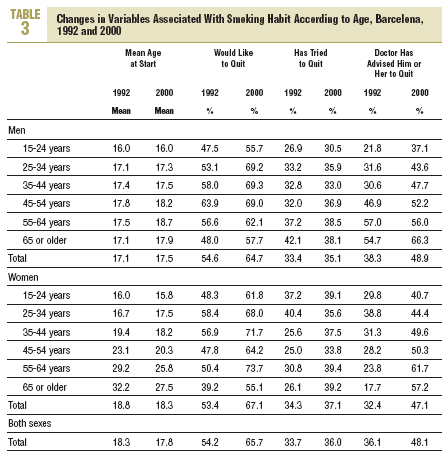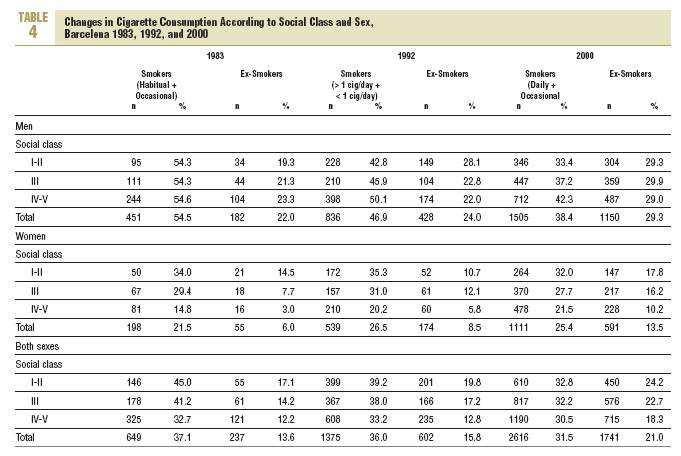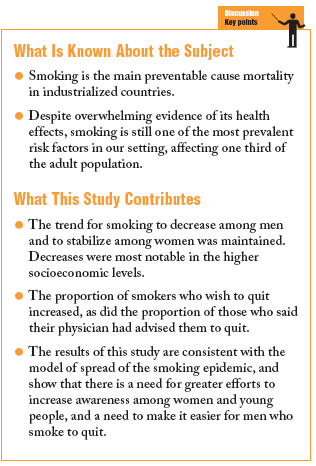to 2000. Design. Time series study. Setting. Health survey based on home interviews of a representative sample of the general population of Barcelona. Participants. In the years 1983, 1992, and 2000 we interviewed 3134, 5004, and 10 000 persons, respectively. Main outcome measures and results. Between 1983 and 2000 daily tobacco use showed a steady tendency to decrease among men, with a prevalence that decreased from 54.6% to 38.3%, while in women, smoking increased between 1983 and 1992 (from 20.9% to 25.4%) but remained stable in 2000 (24.5%). The proportion of smokers who said they wanted to quit increased in both sexes from 1992 (54.2%) to 2000 (65.7%). During this period the proportion of smokers who said their doctor had advised them to quit increased from 36.1% to 48.1%. The trends for both sexes showed that consumption of tobacco products was greater among less privileged socioeconomic groups. Conclusions. The results of this study confirm the decrease in the prevalence of daily consumption of tobacco products and the increase in smokers who would like to quit, in parallel with the increase in advice from physicians to quit. However, the trends among younger groups remained stable, a finding that makes it necessary to intensify efforts aimed at this population group.
Introduction
Despite repeated warnings about the damage caused by smoking--a habit that is responsible for more than 45 000 deaths annually in Spain1--the epidemic has continued to spread in recent years, especially among women.2,3 While the prevalence of the habit has diminished overall in recent decades among men in the European Union, consumption of tobacco products among women has increased steadily.4 Among the causes for this increase are certain beliefs that the cigarette industry has helped to disseminate, such as the presumably lower levels of harm caused by "light" (low tar, low nicotine) cigarettes, and the claims of a relationship between smoking and weight control.4
Between 1982 and 1998 in Catalonia (northeastern Spain) the prevalence of smoking decreased in all age groups among men, whereas the prevalence increased among women, especially in the 24-to-54-year-old age group.5 However, men started their habit earlier, smoked more cigarettes daily, and had greater degrees of dependence.6 Overall figures for Spain between 1987 and 1997 showed that quitting among men increased in all age groups, whereas in women, the proportion who quit increased only in the 25-to-44-year-old group, and only among women in the social classes associated with nonmanual professions.7
In addition to sex, socioeconomic level has been identified as an important variable in trends for cigarette consumption.8 In Spain, as seen in other southern European countries, it was reported in the 1980s that cigarette consumption first declined among men in higher socioeconomic classes, whereas there had been a marked increase in the prevalence among women who belonged to less privileged classes, especially in younger age groups.7,9,10 In older women the highest prevalence was seen among the more privileged social classes, a finding that indicated that we now face phase 3 of the epidemic according to the model of spread of smoking described by López et al.8 English-speaking countries, on the other hand, are in phase 4, characterized by greater consumption by both men and women in less privileged classes.11
In Spain few long-range (historical) studies have been published, making it especially important to obtain indicators that allow us to monitor tobacco product consumption and its trends in relation to sociodemographic factors. This information could be used to design and amend appropriate preventive policies.12 The aim of this study was to describe, on the basis of data from city health surveys, the trends in tobacco product consumption and the changes in associated epidemiologic factors among residents of the city of Barcelona in 1983, 1992 and 2000. We also describe the changes in age when smoking habit started, attitude toward smoking and medical advice to quit received between 1992 and 2000--items that were not included in the 1983 survey.
Methods
The information was obtained from data compiled with the Barcelona Health Survey (BHS) (Encuesta de Salud de Barcelona, ESBA). Data were obtained during home interviews of a sample of the noninstitutionalized population of persons aged 15 years or older. Interviews were carried out in the years 1983, 1992, and 2000 according to survey methods described previously.13-15 The total sample consisted of 3134 persons in 1983, 5004 persons in 1992, and 10 000 persons in 2000. Sampling in 2000 was weighted for each district of the city to obtain a representative sample of 10 030 persons. The survey lasted from January to June in 1983, January to December in 1992, and March 2000 to February 2001 for the 2000 survey.
We compared the responses for the items concerning tobacco product consumption in the years of the survey by persons older than 14 years. In the 1983 survey smokers were considered persons who habitually or occasionally smoked cigarettes, cigars or pipes at the time of the survey, and ex-smokers were considered persons who had smoked previously. For the years 1992 and 2000 smokers were considered persons who smoked one or more cigarettes per day, and ex-smokers were considered persons who had done so previously. To calculate quitting rates the percentage of ex-smokers was divided by the sum of exsmokers and smokers, after excluding nonsmokers.
The 1992 and 2000 surveys included items about motivation for quitting, desire to quit and previous attempts to quit during the previous 12 months. Smokers were asked whether during the week prior to the interview they had been asked to stop smoking in a public area or at home, and whether their physician had ever advised them to quit smoking. Although no data for these items were available from the 1983 survey, we present comparative data for the responses to these items for the years 1992 and 2000.
The participant's social class was determined on the basis of his or her occupation. The adaptation to the Spanish population of the British Registrar General's classification16 was used to identify social class as I professional (managerial and university professionals); II intermediate (professionals with some university-level education); III skilled (manual and nonmnanual) workers; IV skilled and partly-skilled manual workers, or V unskilled manual workers. For the purposes of our analysis, the classes were grouped as I-II, III, and IV-V.
Results
Table 1 shows the changes in prevalence of smoking habit by age and sex for the years 1983, 1992, and 2000. In general, the difference between sexes decreased as a result mainly of the decrease in prevalence in men from 54.6% to 38.3%. In women, on the other hand, there was a slight increase from 1983 (20.9%) to 1992 (25.4%), and no further change in 2000 (24.5%). The net result was a moderate decrease in the overall prevalence of smoking in the general population, such that the proportion of people who smoked daily decreased from 36.2% to 30.9% during the period studied here. The age of maximum consumption remained stable among men at 15 to 34 years, but increased in women, in whom the greatest prevalence was seen in the 15-24-year age group in 1983, the 25-to-34-year group in 1992, and the 35-44-year group in 2000. It should be noted, however, that in 2000 the prevalence in this latter group was similar to that in the youngest age group.
Table 2 shows the changes in quitting rates by age and sex. In the general population there was an increase in the percentage of ex-smokers from 26.7% in 1983 to 31.3% in 1992 and 40.1% in 2000. This increase reflected mainly persons older than 35 years who quit. The increase in quitting rate was seen in both sexes, and the increase in women was greater in relative terms than the increase in men (60% vs 51%). The proportion of ex-smokers increased with age in both sexes, although the increase among women was much larger in relative terms: from 37.6% in those aged 65 years or more in 1983 to 77.7% in 2000. Among men the percentage of ex-smokers in this age group increased from 52.9% to 69.8%.
The changes from 1992 to 2000 in mean age at the start of the smoking habit, the desire to quit, previous attempts to quit, and medical advice to quit are shown in table 3. Mean age at the start of the habit decreased slightly from 18.3 to 17.8 years, mainly as a result of the decrease in mean age in women from 18.8 to 18.3 years. There was also a marked increase in the proportion of smokers who said they would like to quit, which rose from 54.2% to 65.7%, with no notable differences between sexes. However, the proportion of persons who had tried to stop smoking during the preceding 12 months remained stable during this period, with a slight increase from 33.7% to 36%. In both men and women the proportion of smokers who said they had been advised by their physician to quit smoking increased--especially among women--such that in 2000 the proportion approached 50% in both sexes.
Table 4 shows the changes in consumption of tobacco products by social class and sex. In men the socioeconomic differences became larger during the period of study: the proportion of smokers was similar in all socioeconomic groups in 1983, whereas in 2000 the proportion of smokers was much lower in groups I-II (33.4%) than in groups IV and V (42.3%). In women, however, the proportions tended to equalize across socioeconomic groups, with a substantial increase in group IV-V, among whom the proportion of habitual smokers increased from 14.8% to 21.5%.
Discussion
The results of this study disclose some encouraging findings: the trend toward decreasing tobacco use among men was maintained, and the habit showed signs of stabilizing among women, in whom the prevalence of smoking may have reached its peak. Moreover, in the study period there was a marked increase in the proportion of smokers who wished to quit, although the proportion who stated they had tried to quit showed no changes. Of note is the considerable increase in the proportion of smokers who said they had been advised by their physician to stop smoking. In this connection the increasingly active role of primary care professionals in supporting the decision to quit is worth emphasizing.17,18 In contrast, there was no perceptible increase in social pressure to restrict smoking in public areas. A final observation of note is that the results of this study are consistent with the model of spread of the smoking epidemic: the data show a marked decrease among men in the more privileged social classes, while among women, the greatest relative increase was seen in the less advantaged groups.2,3
Before we turn to the implications of the results, some limitations inherent in the methods of the interview-based health survey should be noted. Because this was a cross-sectional study, it is not possible to draw inferences about cause. Moreover, we should note that the items that inquired about the consumption of cigarettes or other tobacco products differed slightly between 1983 and later surveys, and that this made it necessary to analyze habitual and occasional smokers together.
Overall, the trends we observed are similar to those described in other studies during comparable periods both in the autonomous community of Catalonia19 and in other industrialized countries.20 However, our data show for the first time in our setting an overall tendency for smoking to decrease, as the decrease in men was greater than the increase in women. Nevertheless the trend among people aged 15 to 24 years, in whom smoking increased between 1993 and 2000, does not invite optimism in the light of findings in other countries such as the USA, where--despite notable advances in the control of smoking--the trend among young people had not decreased, and in fact increased during the 1990s.21 This trend is probably related with increasingly selective marketing efforts aimed at these age groups.22,23
During the study period there was a substantial increase in the proportion of smokers who wished to quit, although the proportion who said they had tried to quit showed no change. The proportion of smokers who wished to stop smoking--about 70% in 2000--indicates a degree of dissociation between intended behavior and the actual smoking habit which can only be explained by the high, although frequently underestimated, degree of addiction.24 This finding points out the need to facilitate access to resources that will help persons quit, starting with assistance from health professionals--who should be prepared to make greater contributions in this area. In this connection the considerable increase in the proportion of smokers who said they had been advised by their doctor to stop smoking is noteworthy and is a step in the right direction.18
One of the most unexpected findings was that there was no perceived increase in social pressure to restrict smoking in public areas despite the fact that on occasion, social intolerance, and tension are invoked as arguments supposedly against the need to regulate and control smoking. However, we cannot rule out that the apparent stability in perceived social control is not due to lessened social pressures, but rather to the possibility that smokers voluntarily smoke less in public areas. This would make it necessary to obtain other indicators to more precisely monitor social pressure, particularly pressure from nonsmokers.
The results of this study are consistent with the model of spread of the smoking epidemic, as they show a marked decrease in smoking among men in more privileged social classes and at the same time an increase in women in less privileged classes.7,8,25 In other words, the population of Barcelona is in phase 3 of the smoking epidemic, like some countries in southern Europe.11 As noted above, we cannot relax our vigilance: the combination of the enormous addictive power and low social visibility of the health effects of smoking, along with the huge resources the industry devotes to advertising and promotion, make it necessary to maintain policies of active vigilance and control of smoking as a public health problem. Steps should also be taken to ensure that adequate resources are available to undertake this vigilance.
Acknowledgments
To all the investigators of the study HTA-ALERT and to the Grupo de Cumplimiento de la Asociación de la Sociedad Española de Hipertensión y Liga Española para la Lucha contra la Hipertensión (SEH-LELHA).







